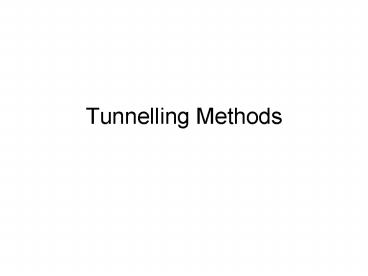Tunnelling Methods - PowerPoint PPT Presentation
1 / 15
Title:
Tunnelling Methods
Description:
Drill and blast. Shields and tunnel boring machines (TBMs) New ... Excavation (or blasting) Supporting. Transportation of muck. Lining or coating/sealing ... – PowerPoint PPT presentation
Number of Views:3682
Avg rating:1.0/5.0
Title: Tunnelling Methods
1
Tunnelling Methods
2
- The choice of tunnelling method may be dictated
by - geological and hydrological conditions,
- cross-section and length of continuous tunnel,
- local experience and time/cost considerations
(what is the value of time in the project), - limits of surface disturbance, and many others
factors.
3
- tunnel construction methods
- Classical methods
- Mechanical drilling/cutting
- Cut-and-cover
- Drill and blast
- Shields and tunnel boring machines (TBMs)
- New Austrian Tunnelling Method (NATM)
- Immersed tunnels
- Special methods (Tunnel jacking, etc.)
4
- The process for bored tunnelling involves all or
some of the following operations - Probe drilling (when needed)
- Grouting (when needed)
- Excavation (or blasting)
- Supporting
- Transportation of muck
- Lining or coating/sealing
- Draining
- Ventilation
5
- Classical Methods
- Among the classical methods are the Belgian,
English, German, Austrian, Italian and American
systems. These methods had much in common with
early mining methods and were used until last
half of the 19th century. - Excavation was done by hand or simple drilling
equipment. - Supports were predominantly timber, and
transportation of muck was done on cars on narrow
gauge tracks and powered by steam. - Progress was typically in multiple stages i.e.
progress in one drift, then support, then drift
in another drift, and so on. - The lining would be of brickwork.
- These craft-based methods are no longer
applicable, although some of their principles
have been used in combination up to present day.
Nevertheless some of the worlds great tunnels
were built with these methods.
6
- The English method (crown-bar method, figure
left) started from a central top heading which
allowed two timber crown bars to be hoisted into
place, the rear ends supported on a completed
length of lining, the forward ends propped within
the central heading. Development of the heading
then allowed additional bars to be erected around
the perimeter of the face with boards between
each pair to exclude the ground. The system is
economical in timber, permits construction of the
arch of the tunnel in full-face excavation, and
is tolerant of a wide variety of ground
conditions, but depends on relatively low ground
pressures.
7
- The Austrian (cross-bar) method required a
strongly constructed central bottom heading upon
which a crown heading was constructed. The
timbering for full-face excavation was then
heavily braced against the central headings, with
longitudinal poling boards built on timber bars
carried on each frame of timbering. As the lining
advanced, so was the timbering propped against
each length to maintain stability. The method was
capable of withstanding high ground pressures but
had high demand for timber.
8
- The German method (core-leaving method) provided
a series of box headings within which the
successive sections of the side walls of the
tunnel were built from the footing upwards, thus
a forerunner of the system of multiple drifts.
The method depends on the central dumpling being
able to resists without excessive movement
pressure transmitted from the side walls, in
providing support to the top 'key' heading prior
to completion of the arch and to ensuring
stability while the invert arch is extended in
sections. - The Belgian system (underpinning or flying arch
method) started from the construction of a top
heading, propped approximately to the level of
the springing of the arch for a horseshoe tunnel.
This heading was then extended to each side to
permit construction of the upper part of the
arch, which was extended by under- pinning,
working from side headings. The system was only
practicable where rock loads were not heavy. - The first sizeable tunnel in soft ground was the
Tronquoy tunnel on the St Quentin canal in France
in 1803, where the method of construction, based
on the use of successive headings to construct
sections of the arch starting from the footing,
was a forerunner to the German system described
above.
9
The Rove Tunnel near Marseille measured 22 x
15,40 m, and was excavated with multiple drifts.
10
Classical multiple face excavation
11
Mechanical Drilling and Cutting-Crushing Strength
of rock
12
Roadheaders
13
Cut and Cover Method
14
- The principal problem to be solved in connection
with this construction method is to how to
maintain surface traffic, with the least
disturbance during the construction period. One
method is to restrict traffic to a reduced street
width, another to direct traffic to a bypassing
street. - Another way of supporting the sidewalls of open
trenches is to substitute sheet-pile walls by
concrete curtain walls cast under bentonite
slurry (ICOS method), and using steel struts.
This is especially a requisite in narrower
streets trimmed with old sensitive buildings with
their foundation plane well above the bottom
level of the pit. This type of trench wall
becomes a requirement for maintenance of surface
traffic due to the anticipation of vibration
effects potentially harmful to the stability of
buildings with foundations lying on cohesionless
soils.
15
(No Transcript)

